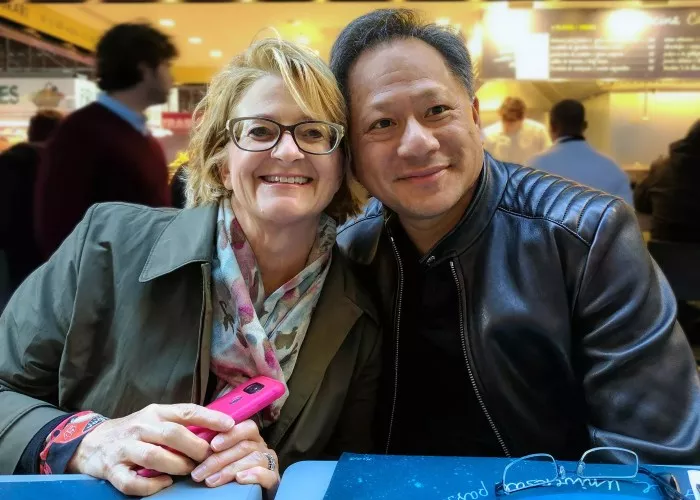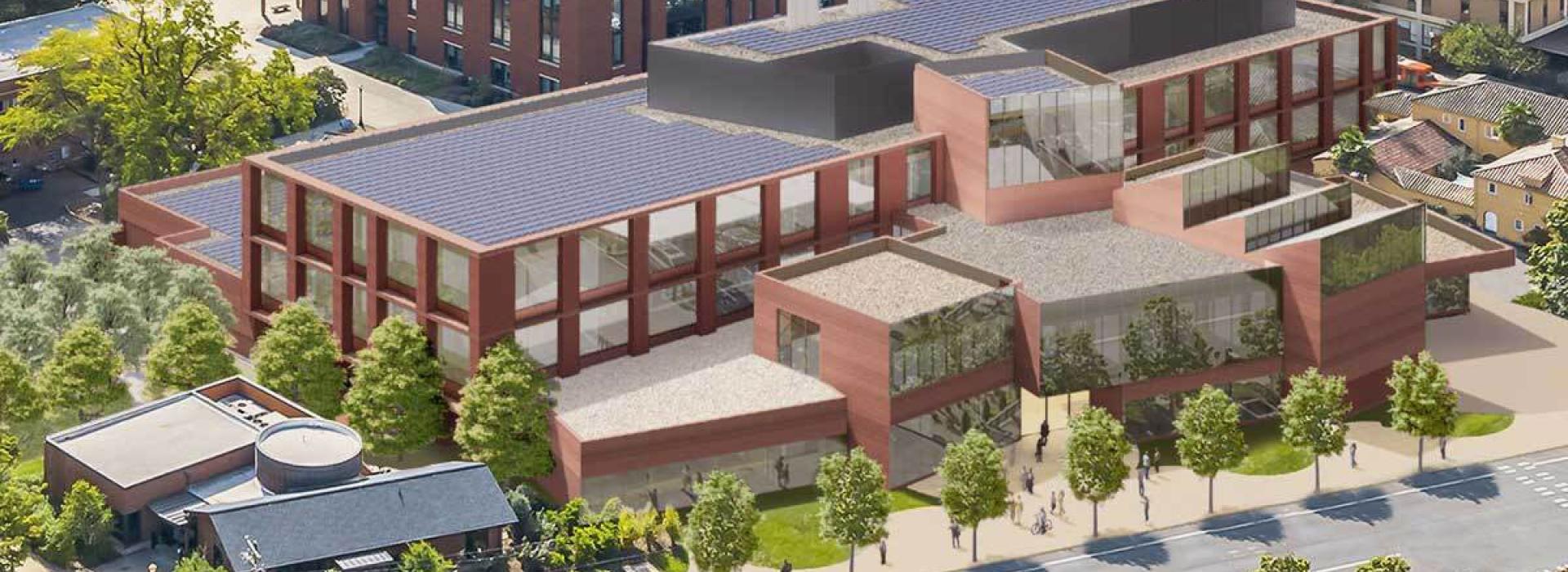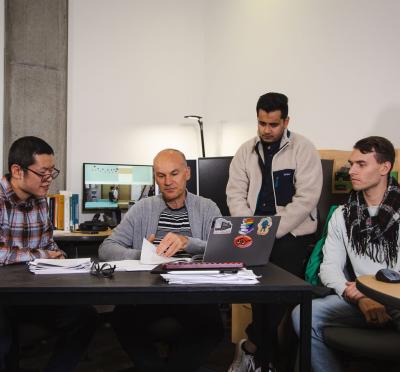Oregon State University has embarked on an ambitious plan to build a $200 million research complex to tackle global challenges by harnessing team-based, transdisciplinary research in multiple areas, including artificial intelligence, materials science, and robotics.
The Jen-Hsun and Lori Mills Huang Collaborative Innovation Complex, targeted for opening in 2025, will support critical advances in priority areas such as climate science, sustainability, and water resources. World-class faculty and students at all levels will collaborate with and empower internationally top- ranked Oregon State programs such as forestry and oceanography, along with several in the College of Engineering. Collaborative innovation will also underpin research and teaching in support of the semiconductor industry and the broader technology sphere in Oregon and beyond.
The complex will be named in honor of two Oregon State Engineering alumni, Jen-Hsun “Jensen” Huang, ’84, and his spouse, Lori Mills Huang, ’85, following their gift of $50 million to the OSU Foundation. The Huangs’ gift was announced the evening of Oct. 14, as the OSU Foundation launched the university’s second-ever universitywide fundraising and engagement campaign.
Designs for the complex are already underway, and construction could begin later this year. Plans call for a three-story, 150,000-square-foot facility to be erected on the northwest corner of the Corvallis campus, along Southwest Memorial Place and Monroe Avenue.
The beating heart of the complex will be a next-generation supercomputer, which will support faculty in addressing highly intricate, challenging computational problems. The complex will also boast specialized research facilities — including laboratories for materials scientists, environmental researchers, and others throughout the university — as well as an extended- reality theater, a robotics and drone playground, high-tech water labs, and a do-it-yourself makerspace.
Oregon State’s new supercomputer — incorporating about 60 NVIDIA DGX SuperPOD and OVX SuperPOD systems — promises to be among the world’s fastest in a university setting, powerful enough to train the largest AI models and to perform sophisticated digital twin simulations. The water used to cool it will help heat more than 500,000 square feet of building space on the Corvallis campus.
Although the Huang Collaborative Innovation Complex is sure to stand out as a prominent new feature on the Corvallis campus landscape, its namesake donors are already well known at Oregon State, and far beyond.
Jensen and Lori Huang first met at Oregon State in the early 1980s, when they both were pursuing undergraduate degrees in electrical engineering. Graduating one year apart, the two would later be married, and they would go on to become one of the tech world’s most successful and most celebrated couples.
Jensen Huang is widely recognized as the leader of NVIDIA, the company he founded in 1993, which he has served since its inception as president, chief executive officer, and member of the board of directors. NVIDIA came to the attention of the world in 1999 with the introduction of the GPU, or graphics processing unit, which changed the face of computing forever.
Today, NVIDIA is a world leader in artificial intelligence and high-performance computing, transforming industries collectively valued at more than $100 trillion — including health care, transportation, and gaming — and profoundly impacting society.
The Huangs trace their shared passion for technology and innovation back to their time at Oregon State.
“We discovered our love for computer science and engineering at OSU,” they said. “We hope this gift will help inspire future generations of students also to fall in love with technology and its capacity to change the world.”
The Huangs identify artificial intelligence in particular, among the many potentially world-changing technologies growing up in our midst, as having a unique power to propel important discovery and innovation across a broad spectrum of academic disciplines.
“AI is the most transformative technology of our time,” they said. “To harness this force, engineering students need access to a supercomputer, a time machine, to accelerate their research. This new AI supercomputer will enable OSU students and researchers to make very important advances in climate science, oceanography, materials science, robotics, and other fields.”
Scott Ashford, Kearney Dean of Engineering, says the complex and its supercomputer will help Oregon State stake its position as a world-leading university for artificial intelligence and robotics.
“It will transform not only the College of Engineering, but the entire university, and have an economic and environmental impact on the state of Oregon and the nation,” he said. “Oregon State faculty, along with collaborators from other universities, business, and state and federal agencies, will pursue techniques in the center’s clean room for making leading-edge computer chips. Robotics researchers and students will be able to use extended-reality theater-aided simulations of drones and robots operating within real-world settings.”
But that’s barely nicking the surface, when one considers the sheer variety and scope of research the complex will enable. For example, Ashford suggests that environmental and electronics researchers working together might design sensors for use at sea or in forests to monitor hard-to-track endangered species, then use AI to analyze the data gathered.
Oregon State University President Jayathi Murthy says the new facility will further efforts to advance diversity, equity, and inclusion in STEM education and research, uniting participants from different fields and backgrounds in a common cause.
“The Jen-Hsun Huang and Lori Mills Huang Collaborative Innovation Complex will be much more than a building,” Murthy said. “It will serve as a universitywide promise, and as a hub for advancing groundbreaking solutions for the betterment of humanity, the environment, and the economy.
“The complex will be a dynamic place where creative, driven faculty, students, and partners from business and other universities come together to solve critical challenges facing the state, nation, and world. We are thrilled by this extraordinary philanthropy and commitment to advancing research discovery and problem-solving.”
Edward Feser, provost and executive vice president at Oregon State, says the complex will build upon Oregon State’s distinction for highly collaborative, team-based research, education, and innovation to harness diverse expertise throughout the university.
“The Jen-Hsun Huang and Lori Mills Huang Collaborative Innovation Complex will be an incredible contributor to our state and world by supporting innovation, entrepreneurship and partnerships with industry and other higher education institutions,” Feser said.
Feser also identified the complex as a key component of efforts championed by federal, state, business, and academic leaders to support the competitiveness of Oregon’s semiconductor industry.
“OSU is committed to supporting the full workforce development pipeline for the sector, by partnering with community colleges and other Oregon universities to create seamless pathways to traditional and alternative credentials and by preparing bachelor through PhD degree graduates,” he said.
During the 2023 Oregon legislative session, Oregon State University will request $75 million in state-paid bonding to match philanthropic and university contributions for the complex. The university and OSU Foundation also will seek additional public, private sector, and philanthropic support for equipment, faculty support, and research programs within the complex. This will include funding to support targeted faculty hires and the university’s goals to increase diversity in STEM fields.
Sen. Ron Wyden, who along with former Gov. Kate Brown has been prominent in support of the state’s semiconductor industry, praised the university’s plans.
“It’s no secret that advanced computer chips are the linchpin of the 21st century economy,” Wyden said. “This state-of-the-art facility provides opportunity for Oregon State faculty and students to make generation-defining discoveries to push our tech industry forward. I am very excited for Oregon State to open this incredible facility and bring together the best and brightest to provide interdisciplinary solutions to complicated problems.”
Brown also voiced support for the collaborative innovation complex.
“Our state has benefited greatly from having a world-class research university like Oregon State University to allow us to develop further technological innovations and grow our high-tech workforce,” Brown said. “The collaborative innovation complex will further enable OSU’s world-class researchers and facilities to address some of Oregon’s most pressing issues, including semiconductor research and development, climate change and public health.”
OSU Foundation CEO and President Shawn Scoville praised the Huangs’ philanthropy.
“Lori and Jen-Hsun are exceptional Oregon State alumni and truly visionary philanthropists,” Scoville said. “They bring so much to the table. Every project they are involved in is improved because of their input, and OSU is the great beneficiary of their experience and active engagement. It is a joy and an honor to work with them.”
Believe it.
Campaign aims to raise $1.75 billion to support priority initiatives

This past fall, Oregon State University and the OSU Foundation launched Oregon State’s second universitywide fundraising campaign, Believe It: The Campaign for Oregon State University.
Donors have already committed more than $1 billion to the campaign, which seeks to raise $1.75 billion to support Oregon State’s priority initiatives.
Led by the OSU Foundation, the Believe It campaign is planned to support $460 million for student support, including scholarships, fellowships, and experiential learning funds; $500 million for faculty positions and academic program support; $320 million for new facilities, renovations, and equipment; $250 million for emerging strategic initiatives; and $220 million for programmatic support, including outreach and extension programs throughout Oregon and beyond.
“As Oregon’s public land grant university, Oregon State is ideally suited to serve Oregonians in all communities, and provide solutions to challenges that face the nation and world,” said President Jayathi Murthy. “The phenomenal support already provided to the Believe It campaign is a testament to Oregon State’s donors and their belief in the university’s ability to help transform the lives of learners of all ages and promote social, cultural, and economic progress within Oregon and beyond.”
The university and the OSU Foundation began working on the Believe It campaign in 2017 with then- President Edward Ray, aligning campaign priorities with the university’s Vision 2030 and Strategic Plan 4.0. Donors to date have created nearly 500 new scholarship, fellowship, and student support funds, an increase of 26% since the campaign began.
“We concluded our first campaign in 2014 having raised $1.14 billion, but just as important, we created a catalyst for philanthropy at OSU,” said Shawn L. Scoville, OSU Foundation president and CEO.
The campaign also seeks to grow and deepen the involvement of alumni and other supporters in ways that advance student success and a sense of belonging to the larger community of more than 200,000- alumni and 300,000 parents and friends worldwide, Scoville said.
Find out more at fororegonstate.org.
About the Huangs
Jensen Huang founded NVIDIA in 1993 and has served since its inception as chief executive officer, president, and a member of the board of directors.
Starting out in PC graphics, NVIDIA helped build the gaming market into the world’s largest entertainment industry. The company’s invention of the GPU in 1999 made possible real-time programmable shading, which defines modern computer graphics, and later revolutionized parallel computing. More recently, GPU deep learning ignited modern AI — the next era of computing — with the GPU acting as the brain of computers, robots, and self-driving cars that can perceive and understand the world.

Huang was inducted into the College of Engineering’s Hall of Fame in 2013. He is a recipient of the Semiconductor Industry Association’s highest honor, the Robert N. Noyce Award; the IEEE Founder’s Medal; the Dr. Morris Chang Exemplary Leadership Award; and honorary doctoral degrees from Taiwan’s National Chiao Tung University, National Taiwan University, and Oregon State University. He was included in Time magazine’s 2021 list of the world’s 100 most influential people. In 2019, Harvard Business Review ranked him No. 1 on its list of the world’s 100 best-performing CEOs over the lifetime of their tenure. In 2017, he was named Fortune’s Businessperson of the Year.
Prior to founding NVIDIA, Huang worked at LSI Logic and Advanced Micro Devices. He holds a Master of Science in Electrical Engineering from Stanford University. Huang has said the highlight of his time at Oregon State was meeting Lori, when they were paired as lab partners in an electrical fundamentals class.
“That was the most important, single event of OSU, and of my life,” he said.
Lori Huang is president of the Jen-Hsun and Lori Huang Foundation, supporting higher education, public health, and STEM initiatives across the U.S. alongside local community organizations in the San Francisco Bay Area.
The Huang Foundation previously gave $5 million to build a laboratory for cancer research at Oregon State, and $30 million for the Jen-Hsun Huang Engineering Center at Stanford University. The Huangs joined Melinda Gates in supporting AI4ALL, a national nonprofit working to increase diversity and inclusion in AI. They have also made major educational grants to Johns Hopkins University and City Year San Jose.
The Huangs have two children.



